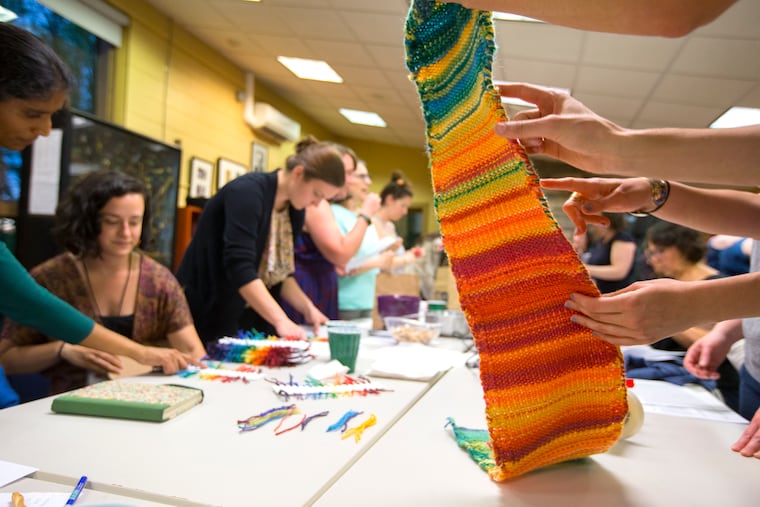Activist crafters at Philly’s new ‘Tempestry’ knitting group are sounding the alarm on global warming
Knitters and crocheters are creating scarf-shaped banners that are color-coded bar charts showing daily temperatures in Philadelphia from 1875 to 2018.

The Schuylkill Center for Environmental Education in Roxborough has been teaching Philadelphians about the natural world since 1965 — but never like this.
On a Tuesday night in late April, 30 activist crafters convened there for the first Philly chapter meeting of a nationwide initiative that is sounding the alarm on global warming. With science. And yarn.
One lively group sat around a large table weighing fibers on electronic balances. A smaller contingent worked diligently in a corner, winding colorful skeins with names like Peapod and Firecracker.
All are volunteers for the Tempestry Project, an initiative founded in Washington state two years ago that now has chapters coast to coast and abroad. Tempestry is short for “temperature tapestry.” Group members knit or crochet scarflike banners designed as bar charts of local temperature data over time, with bands of color progressing from cool blues and greens to hot oranges and reds.
The new Philly group is the largest outpost of the project to date.
“I think [the response] is a testament to the power of the project," said local Tempestry organizer Christina Catanese,"giving people something tangible to do and using the craft for a bigger cause than making hats or blankets.”
Catanese is the Schuylkill Center’s director of environmental art. For local temperature data, she reached out to the Franklin Institute, which has been measuring the city’s daily temperature since 1872. The local group’s Tempestry tapestries will represent local temperatures from 1875 to 2018.
Where Tempestries come from
The first Tempestry was based on 2016 data taken from the Naval Air Station on Whidbey Island, Wash. Project founders Emily McNeil, Justin Connelly, and Marissa Connelly were inspired by scientists and hackers who were taking measures to preserve climate research data before the Trump administration took office.
“We were just sort of joking one night about how we should return to more concrete forms of data storage, like tapestries, because you can’t just get rid of them on the internet,” McNeil said by phone from Anacortes, Wash., where she manages Fidalgo Artisan Yarn & Clothing.
Word about the venture quickly spread via social media. McNeil and her partners started assembling Tempestry kits for those who wanted to get involved. Demand soared. In 2017, they sold 40 kits. In 2018, 500 people bought them.
“We’re not knitting [Tempestries] ourselves anymore, but we have people in every state except Delaware,” she said. Crafters in Mexico City are also developing a Tempestry collection similar to Philadelphia’s.
Philly joins the cause
Catanese first reached out to McNeil in January about getting the Schuylkill Center involved. Some climate change art "feels very distant and disconnected,” she said. To counter that, the center likes to ask, “What are climate change impacts in Philadelphia?” and seek out artists who are exploring those ideas.
Previous climate-focused art projects there have ranged from sculptures that manage storm water to a hybrid nature walk/dance performance.
Catanese has a master’s degree in applied geosciences from the University of Pennsylvania and previously worked at the Environmental Protection Agency’s Philadelphia office. She’s also a dancer and choreographer, and a hobbyist who’s been knitting for about 10 years.
“My grandma knitted a lot when I was growing up [in Pittsburgh], but I never learned from her,” she said.
When Catanese put out a call for volunteers on the Schuylkill Center’s website, she received about 100 replies. Her original goal was to make Tempestries that illustrated changes in Philly’s annual temperature over 10-year intervals from the late 1800s to 2018. Thanks to the enthusiastic response to the initiative, the project will represent data from every five years within that period.
Thirty knitters and crocheters have each been assigned a different year, with additional participants serving as “alternates” who will assist the core group. The local project has all the crafters it needs right now, but would-be volunteers can sign up for a wait list.
Chris Arnott, 40, has the assignment to crochet Philly’s weather from 1945. She’s a biologist with the National Park Service and has been crocheting for eight years.
Arnott, who lives in Mount Airy with her husband and 2-year-old son, learned about the project through the Schuylkill Center’s Facebook page. It appealed to her because she could complete it while staying home with her son. Volunteers are also invited to join monthly knit-ins at the center.
Nora Trejos, 31, of West Philly, will be making a Tempestry for 1915. She heard about the project from a friend who works for the city.
Maureen Keeney, 55, of Broomall, is an alternate, and this is her second experience with a wide-scale fiber art project. In June 2018, she crocheted blocks for “Love Across the USA: Marian Anderson,” a tapestry that was part of a series celebrating strong women. It’s now on display at Philly’s Marian Anderson Recreation Center.
She was drawn to the Tempestry Project because "it really helps when people can get a visual representation of what is going on” with climate change, she said. “To see the progression over time will be really impactful.”
Kindergarten teacher Ann Ward is a knitting newbie. Her Tempestry will show temperature data from 1965, the year she was born. Next year, she hopes to start a companion project with her class.
Each tapestry takes about 20 hours to complete. The goal, Catanese says, is to have the Philadelphia collection finished by fall.